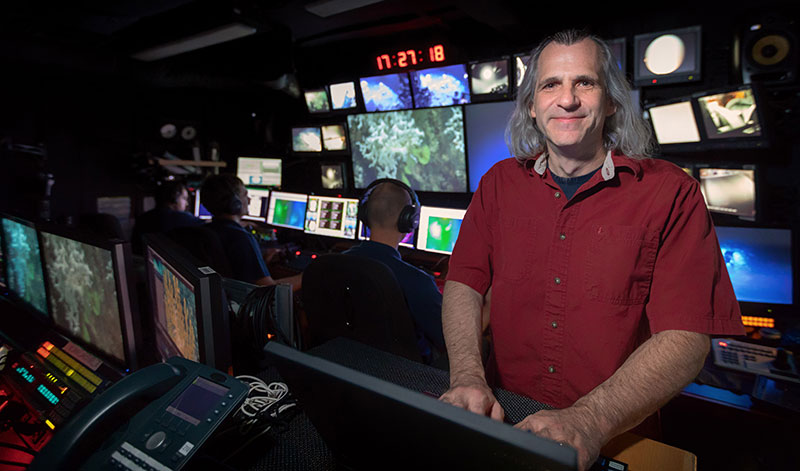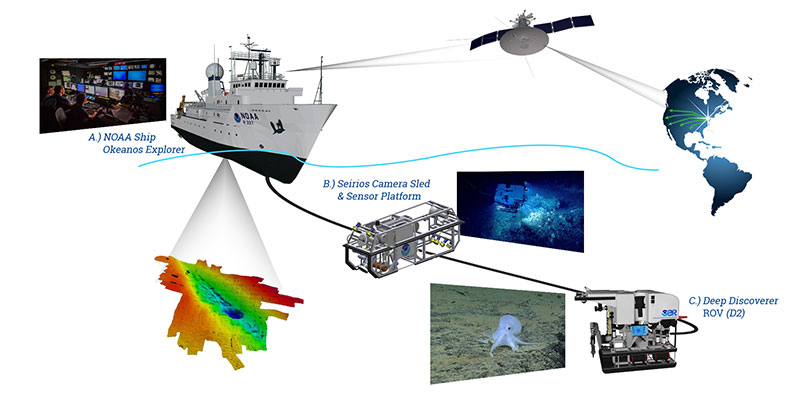
by James Rawsthorne, Telepresence Coordinator, NOAA Office of Ocean Exploration and Research
June 19, 2018

New Telepresence Coordinator for the NOAA Office of Ocean Exploration and Research, James Rawsthorne, working in the control room aboard NOAA Ship Okeanos Explorer while in the Atlantic Ocean for Windows to the Deep 2018: Exploration of the Southeast U.S. Continental Margin expedition. Image courtesy of the NOAA Office of Ocean Exploration and Research, Windows to the Deep 2018. Download larger version (jpg, 2.6 MB).
When I was recently asked to work with the NOAA Office of Ocean Exploration and Research (OER) program as Telepresence Coordinator, it was something of a dream come true. As a life-long Trekkie, telepresence sounded a lot like teleportation, which as fellow Star Trek fans well know, was when a small group of the intrepid crew of the Enterprise would climb onto a platform – then beam [teleport] down to a planet to explore. Sensors would be handily strapped to their sides to investigate this previously unknown place. Upon completion of teleportation, immediately out came the tricorders to take readings of unknown life forms and geologic features. Audio communicators in hand, they would relay back information to the Enterprise of what they found, having an immediate back and forth of data and further instructions as the scene developed.
An overview of how telepresence on E/V Nautilus and NOAA Ship Okeanos Explorer works. Video courtesy of the NOAA Office of Ocean Exploration and Research. Download video (mp4, 9.5 MB).
It turns out OER’s telepresence is even better! Rather than a select crew of six beaming down, we send remotely operated vehicles (ROVs), sensors, and high-definition cameras deep into the ocean to previously unexplored places to stream back video and data live in real time for participants around the globe to watch and contribute to the research. Scientists remotely located are able to study, communicate, and contribute to the research effort as it happens without having to climb aboard the ship for often long journeys. They are able to continue their work and schedules without interruption.
We have Exploration Command Centers (ECCs) designed for researchers to visit where they can participate in the explorations and work in the same collaborative, multidisciplinary environment that one might expect onboard a ship. We also stream our high-definition video and data live to the public, so citizen scientists and all interested in ocean exploration can follow along as we investigate and explore.

A telepresence-enabled platform, NOAA Ship Okeanos Explorer uses satellite technology to transmit data and video in real time from the ship and remotely operated vehicles (ROVs) working at depth, to a shore-based hub where the video is transmitted in high definition out on the Internet and Internet2 to research facilities, educational institutions, Exploration Command Centers, and the general public. Image courtesy of the NOAA Office of Ocean Exploration and Research, Windows to the Deep 2018. Download larger version (jpg, 420 KB).
I am currently onboard NOAA Ship Okeanos Explorer for the Windows to the Deep: Exploration of the Southeast U.S. Continental Margin expedition. After having spent five years on the OER engagement web team, this is my first expedition aboard the Okeanos Explorer, and it is a very exciting first hand look at the scientific exploration and data gathering that occurs. This journey is a great opportunity to think about new ways to bring the fascinating activities that occur on the Okeanos to those who participate from shore. My mission as telepresence coordinator (and occasional web developer) is to transfer as much of what happens onboard to those who join us remotely, whether it be at one of our high-tech ECC’s or online via desktops and mobile devices.
It has always been a goal for me to bring the exciting research and exploration that goes on in government science programs not only to scientists, but to make it available in an interesting way to everyone. I know of no better way to show the value of our research than to show it happening in real time, as it happens. To bring our efforts to not only scientists, but to students, the general public, and all who are interested to follow and contribute is the cumulation of years of development and progress. With the advent of satellite technology and widely available broadband internet, this dream is a reality that I am proud to be a part of.
The Deep Discoverer remotely operated vehicle is at the forefront of the OER telepresence program and gives scientists unprecedented access to the deep ocean, from delivering stunning high-definition video and gathering physical data about surrounding waters, to allowing the collection of biological and geological samples. Video courtesy of the NOAA Office of Ocean Exploration and Research, Gulf of Mexico 2017. Download larger version (mp4, 119.2 MB).
Ours is more than a nine-year mission, and I encourage everyone to join us as we chart new territory, explore new environments, revisit shipwrecks, and discover unknown species and life forms. Our missions go to many places and cover a breathtaking array of subjects. So accompany us live via telepresence, while we boldly go where no human has gone before.